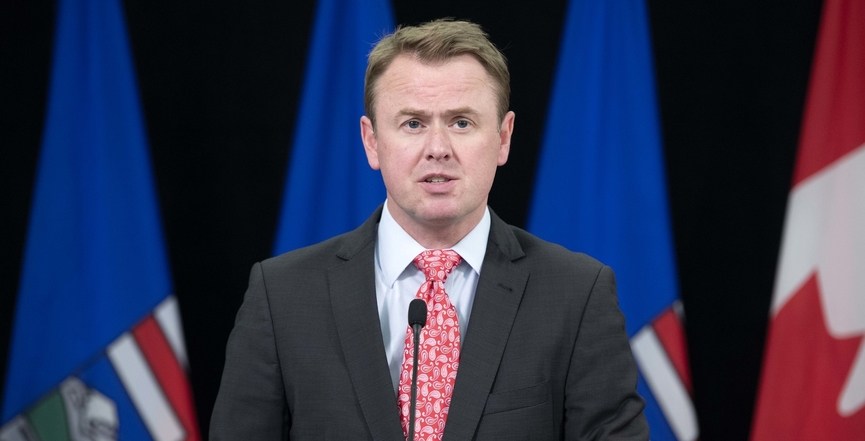The Kenney government yesterday again escalated its continuing war with the Alberta Medical Association (AMA), indicating it would consider letting rival groups representing medical specialties quit the doctors’ collective bargaining association and negotiate directly with the government.
In a statement obviously intended to rock the AMA, Health Minister Tyler Shandro commented favourably on a news release by the Eye Physicians and Surgeons Association of Alberta (EPSAA) that called on the government to let it bypass the AMA and bargain directly on behalf of Alberta’s ophthalmologists.
Shandro also directly thanked EPSAA president Vikram Lekhi, who is also president of the AMA’s ophthalmology section, “for contributing to this important policy discussion.” Needless to say, given the timing, that contribution could seriously undermine the AMA’s bargaining position.
The EPSAA release yesterday called for legislative changes that would permit it and other medical specialists’ organizations to negotiate their own deals with the government.
In a longer open letter addressed to Shandro also dated yesterday, Lekhi, EPSAA past president John Huang, and executive director Ian MacLeod complained the AMA has resisted “innovative systems changes” — a term that to many observers smacks of more privatization.
Meanwhile, in a statement to AMA members headed “We are under attack,” AMA president Christine Molnar assailed Shandro for “disrespectful, misleading and, frankly, baffling behaviour,” and argued the fact is now unassailable “that our profession is under attack by government.”
“The pillars of our profession are threatened,” she wrote. “We are witnessing changes to self-regulation at the College of Physicians & Surgeons of Alberta, with ministerial directives to the College that threaten basic charter rights. … Our rights to arbitration have been taken from us.”
In an interview with the CBC, she called the United Conservative Party government’s action since Shandro tore up the AMA’s contract without notice last February, “a premeditated plan.”
Molnar’s statement continued: “Having just received the news, I am disappointed that EPSAA colleagues believe that their interests are divergent from that of the AMA. We do not yet understand what process was followed and will be seeking more information.”
The backstory to the EPSAA’s split with the AMA is a longstanding and widespread view among ophthalmologists — and doubtless practitioners of other surgical specialties — that the AMA is too focused on the concerns of family physicians.
This has resulted in the perception among many Alberta eye surgeons that the AMA has not taken into account the true costs of their practice — which over time has been one of the highest-billing specialties in the medical profession.
The specialty also has its own internal disagreements — for example, competition between academic eye-surgery programs and non-hospital surgical facilities for public resources, but for now the eye surgeons’ rift with the AMA has given the government an effective wedge in its ongoing effort to weaken the association.
For most Albertans, of course, the government’s animus toward the AMA during a pandemic is inexplicable and certain to be causing growing unease — especially in light of talk by many family practitioners they are ready to leave Alberta for other provinces.
The CBC analysis yesterday tied the fight to the government’s pre-COVID-19 efforts to balance the budget and Premier Jason Kenney’s instinct “to seek out enemies and use them as rhetorical punching bags in service of his agenda.”
But that doesn’t really account for Kenney’s and the UCP’s apparent hostility toward family doctors, or the UCP’s ideological commitment to pushing private delivery of health care as far as possible under cover of the emergency created by the global coronavirus pandemic.
Could the bitterness of their fight be inspired by the fact the AMA negotiated with with the NDP during the four years of Rachel Notley’s government, instead of undermining it, as did other groups traditionally connected to Conservative politics in Alberta?
Meanwhile, Alberta’s COVID-19 emergency continues, with the province now reporting more than 1,100 active cases, the highest number since May 12. Alberta posted 165 new COVID-19 cases on Friday, 106 more on Saturday, and another 97 Sunday.
Nevertheless, Alberta Health officials are sticking with the narrative the surge in cases is caused by Albertans becoming complacent and tired of restrictions on their lives, not the timing of the government’s reopening of the economy.
David Climenhaga, author of the Alberta Diary blog, is a journalist, author, journalism teacher, poet and trade union communicator who has worked in senior writing and editing positions at The Globe and Mail and the Calgary Herald. This post also appears on his blog, AlbertaPolitics.ca.
Image: Alberta Newsroom/Flickr



